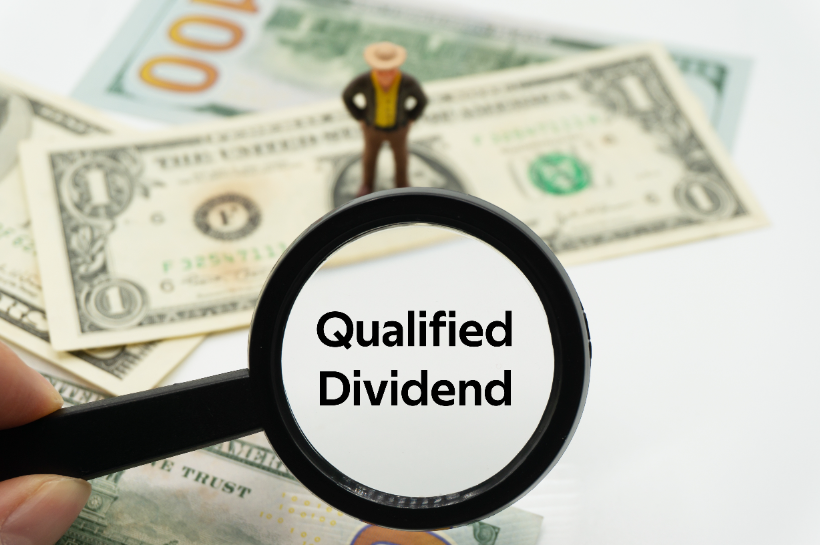
It’s a battle! Qualified vs nonqualified dividends. If you’re looking for the thrill of the day trader, expect a bit of a tax hangover.
Qualified dividends are a specific type of dividend payment that is subject to lower tax rates than ordinary dividends. Dividends from shares are typically paid to shareholders of stock as a portion of the company’s profits. To qualify for preferential tax treatment, dividends must meet certain criteria set by the Internal Revenue Service (IRS).
Qualified dividend income must be paid by a U.S. corporation or a qualifying foreign company before it can count as qualified. The shareholder must also own the stock for a specific period of time, known as the holding period requirement. Generally, the holding period requirement is at least 61 days within a 121-day period for common stocks or 91 days within a 181-day period for preferred stocks.
For individuals in lower-income tax brackets, qualified dividends are typically taxed at a reduced rate or may even be tax-free. The tax rates on qualified dividends are generally lower than the ordinary income tax rates. Higher-income individuals may also be subject to an additional tax on net investment income.
Overview of Capital Gain Tax Worksheet
The Capital Gain Tax Worksheet is a crucial tool that individuals must utilize to calculate the tax owed on capital gains. It plays a significant role in the broader context of understanding qualified dividends and capital gain tax.
Capital gains are profits earned through the sale or exchange of assets like stocks, bonds, or real estate. These gains are subject to taxation at different rates, depending on various factors such as the holding period and income bracket. To accurately determine the tax owed on capital gains, the Capital Gain Tax Worksheet is employed. If your sales can qualify as qualified dividends, they’ll get a more favorable tax treatment instead of hitting your marginal income tax rate.
By using the worksheet, taxpayers can document and calculate their capital gain or loss, consider any applicable deductions or exemptions, and establish their tax liability. It allows individuals to organize and report their investment earnings in a structured manner, ensuring compliance with tax laws.
Understanding how the federal government taxes capital gains and their inclusion in the Capital Gain Tax Worksheet is crucial to accurately and efficiently prepare taxes.

Distinct Types of Dividends: Qualified vs. Nonqualified Dividends
Dividends are a form of investment income that shareholders receive from companies they hold stock in. They are typically distributed as cash payments, and understanding the different types of dividends can help investors make informed decisions.
Qualified dividends are subject to lower tax rates due to their preferential status while non-qualified dividends are taxed at an individual’s ordinary income tax rate.
Qualified dividends meet specific criteria set by the Internal Revenue Service (IRS), such as holding period requirements. To be considered qualified, the dividends must be received from domestic corporations or qualified foreign corporations, and shareholders must hold the stock for a specific period of time.
On the other hand, non-qualified dividends include payments from tax-exempt companies or foreign corporations that do not meet the IRS criteria. They are typically taxed at higher rates, potentially increasing the tax liability for shareholders. A smart strategy would be to hold these funds in a tax-advantaged account in some way to maximize profits after dividends hit their marginal tax rate.
Common Stock Dividends
Common stock dividends are a common form of return on investment that shareholders receive from companies they have invested in. These dividends are distributed by companies as a share of their profits to their shareholders. Understanding the taxation of common stock dividends is crucial for investors to effectively manage their investment income.
When it comes to tax purposes, common stock dividends can be categorized as either qualified or non-qualified dividends. Qualified dividends are subject to lower tax rates and receive preferential treatment. On the other hand, non-qualified dividends are taxed at an individual’s ordinary income tax rate.
To be considered qualified, common stock dividends must meet certain requirements set by the Internal Revenue Service (IRS). Firstly, they should be received from domestic corporations or qualified foreign corporations. Secondly, shareholders must hold the stock for a specific period of time known as the holding period. This holding period is generally 60 days within a 121-day period for common stocks. The ex-dividend date on the other hand is when the income gets paid and a new buyer could start making future dividends on the share.
The holding period is an important factor in determining the tax treatment of dividends. It ensures that investors hold the stock for a sufficient duration to reap the benefits of the lower tax rates on qualified dividends. Holding the stock for the required holding period allows investors to take advantage of the tax benefits associated with qualified dividends.
Preferred Stock Dividends
Preferred stock dividends are a unique type of dividend that differ from common stock market income in terms of priority and payment structure. While common stock dividends are paid out of a company’s profits after all other obligations are met, preferred stock dividends are generally given priority and are paid before common stock dividends.
One of the key characteristics of preferred stock dividends is that they have fixed payment amounts. Unlike common stock dividends, which can vary depending on a company’s performance, preferred stock dividends are predetermined, providing investors with a more predictable income stream. This can be especially attractive for investors who rely on dividend income as a source of regular cash flow. In those cases, value investing can be appealing if you’re in a recessionary market condition or bear market.
In addition, preferred stock dividends may have the potential for cumulative payments. This means that if a company fails to pay a preferred stock dividend for a certain period of time, the unpaid dividends accrue and must eventually be paid in full before any common stock dividends can be distributed. This feature offers an added layer of security for investors, as it allows them to potentially receive missed payments in the future.
While there are advantages to investing in preferred stocks, such as higher dividend yields and potential preferential treatment in certain tax situations, there are also disadvantages to consider. Preferred stocks typically do not offer the same potential for capital appreciation as common stocks and may be less liquid. Additionally, preferred stock dividends may be subject to restrictions or reductions if a company’s financial performance deteriorates.
Real Estate Investment Trusts (REITs) Dividends
Real Estate Investment Trusts (REITs) offer a unique way for investors to receive dividends from their investments. Unlike regular dividends, which are distributed by companies based on their profits, REITs are required by law to distribute a significant portion of their taxable income to shareholders in the form of dividends.
REITs are companies that own and operate income-generating real estate properties, such as office buildings, shopping centers, and apartments. They generate revenue from rental income and capital appreciation of the properties they own. To qualify as a REIT, these companies must meet certain requirements, including distributing at least 90% of their taxable income to shareholders.
One of the major advantages of investing in REITs is the tax benefits they offer. REIT dividends are generally taxed at the investor’s ordinary income tax rate, rather than the higher tax rates applied to qualified dividends or long-term capital gains. This means that investors may be able to reduce their tax liability by investing in REITs, especially for those in higher tax brackets.
Additionally, REITs can provide investors with a steady and consistent income stream compared to a money market account. Due to the requirement to distribute a significant portion of their taxable income, REITs often offer higher dividend yields compared to other types of investments. This can be particularly attractive for income-focused investors who rely on dividends for regular cash flow.

Mutual Fund Distributions
Mutual fund distributions refer to the dividends paid out to investors who hold shares in mutual funds. These distributions can consist of both ordinary dividends and capital gains distributions. However, in order for these dividends to be considered qualified dividends, certain requirements must be met.
One such requirement is the holding period. To qualify as a qualified dividend, the security or mutual fund must be held unhedged for at least 61 days out of the 121-day period before the ex-dividend date. For example, let’s say an investor purchases shares of a mutual fund on January 1st. The fund’s ex-dividend date is on March 15th, meaning the investor must hold the shares until at least February 1st to meet the holding period requirement.
Meeting these requirements allows investors to enjoy the tax benefits associated with qualified dividends. Qualified dividends are taxed at a lower long-term capital gains rate, which can result in significant tax savings for investors. Non-qualified or ordinary dividends tend to hit your marginal tax rate, which is based on your income tax bracket. Depending on the sale, that could be a big chunk of taxes out of a substantial dividend yield. The differences in taxation can make a significant difference per dollar of income earned when your income is based on seeing an increase in stock prices.
Which Are Qualified Dividends?
Qualified dividends refer to a specific type of dividend that provides investors with certain tax advantages. To be considered qualified, dividends must meet specific criteria imposed by the Internal Revenue Service (IRS). One such requirement is the holding period, where the security or mutual fund must be held for a certain duration before the ex-dividend date. For example, for a stock, it must be held unhedged for at least 61 days out of the 121-day period before the ex-dividend date. Meeting these requirements allows investors to enjoy the tax benefits associated with qualified dividends, which are taxed at a lower long-term capital gains rate. This can result in significant tax savings for investors. Overall, understanding the criteria for qualified dividends is crucial for investors seeking to make the most of their investment income while minimizing their tax liability.
How to Identify Qualified Dividends
To identify qualified dividends, certain criteria must be met. First and foremost, the dividend must be paid by a U.S. or qualifying foreign company that meets specific requirements can also qualify.
Another important factor is the 60-day holding period in the 121-day period beginning 60 days before the ex-dividend date or common stocks and mutual funds. However, preferred stock requires a holding period of at least 90 days during the same 121-day period. Sell too soon, and you’ve got nonqualified dividends.
It is also essential to note that the Internal Revenue Service (IRS) provides a non-qualifying list of dividends that do not meet the criteria for qualified status. It is crucial to review this list and confirm that the dividends being received are not listed as non-qualifying.
By ensuring that the dividend is paid by a U.S. or qualifying foreign company and meets the required holding period, investors can identify qualified dividends and take advantage of the preferential tax treatment they offer. As always, it is advisable to seek professional advice to fully understand the complexities of qualified dividend taxation and its impact on individual circumstances.
Qualified Dividend Requirements
First, a U.S. corporation or a qualified foreign corporation has to pay the dividend for it to even count as qualified. Dividends received from foreign companies that meet specific criteria can also be classified as qualified dividends.
Secondly, the dividend should not fall under the category of regular dividends, which are distributions made by tax-exempt organizations, mutual funds, real estate investment trusts, or certain other types of investments. Regular dividends are subject to the ordinary income tax rate.
Additionally, a qualified dividend must satisfy the holding period requirement. You have to hold common stocks and mutual funds for at least 61 days during the 121 day period beginning 60 days before the ex-dividend date. You have to hold onto preferred stock, on the other hand, for at least 91 days during the same 121-day period.
It is crucial for investors to understand the distinction between regular and qualified dividends, as qualified dividends are taxed at the lower long-term capital gains rate. To confirm the status of dividends, it is recommended to consult a tax professional or review the guidelines provided by the IRS. By meeting these requirements, investors can enjoy the preferential tax treatment of qualified dividends.
What are ordinary, nonqualified dividends?
Ordinary, non-qualified dividends are a type of dividend that is subject to taxation at an investor’s ordinary income tax rate. This means that the tax rate for these dividends depends on the investor’s overall income level.
Unlike qualified dividends, which can qualify for lower tax rates, non-qualified dividends are taxed at the higher ordinary income tax rates. The tax rate for ordinary dividends is determined by the investor’s tax bracket, which ranges from 10% to 37% based on their taxable income.
It is important to note that the taxation of dividends is influenced by the income level and tax bracket of the investor. Lower-income individuals typically face lower tax rates on their ordinary dividends, while higher-income individuals may be subject to higher tax rates. If you’ve got the risk tolerance and savvy to maintain your individual portfolio, a smart strategy would be to transition qualified vs non-qualified dividend investing as your taxable income grows. Getting the capital gains tax treatment can make a significant contribution to your taxable accounts.

The Tax Benefits of Qualified vs. Non-Qualified Dividends
When it comes to dividend income, there are distinct tax benefits associated with qualified vs nonqualified dividends. Qualified dividends save taxes for investors by qualifying for long-term capital gains tax rates.
Qualified dividends actually qualify for the long-term capital gains tax rate. And that’s good news, because long-term gains is usually better. For example, the long-term capital gains tax rate for most taxpayers is 0%, 15%, or 20%, depending on their taxable income. In contrast, non-qualified dividends are taxed at the higher ordinary income tax rates, which can range from 10% to 37%.
To illustrate the difference in tax burden, let’s consider two individuals, both receiving $10,000 in dividend income. The lower-income individual whose dividends are qualified may only pay 15% in taxes, resulting in a tax liability of $1,500. On the other hand, the higher-income individual, whose dividends are non-qualified, may be subject to a 37% tax rate, resulting in a tax liability of $3,700.

Jacob Dayan
Entrepreneur • CEO Community Tax, LLC
Jacob Dayan is the CEO and co-founder of Community Tax LLC, a leading tax resolution company known for its exceptional customer service and industry recognition. With a Bachelor’s degree in Business Administration from the University of Michigan’s Ross School of Business, Jacob began his career as a financial analyst and trader at Bear Stearns and Millennium Partners before transitioning to entrepreneurship. Since 2010, he has led Community Tax, assembling a team of skilled attorneys, CPAs, and enrolled agents to assist individuals and businesses with tax resolution, preparation, bookkeeping, and accounting. A licensed attorney in Illinois and Magna Cum Laude graduate of Mitchell Hamline School of Law, Jacob is dedicated to helping clients navigate complex financial and legal challenges.










